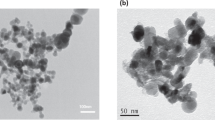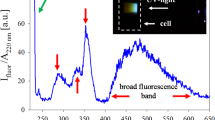Abstract
IN a communication to NATURE1 entitled "Mechanism of Optical Sensitizing of Silver Halides by Dyes", We described briefly some experimental results showing that sensitizing dyes adsorbed to silver halides produce by absorption of light in their own absorption bands decomposition of the silver halide into metallic silver and free halogen. In the presence of adequate halogen acceptors, the dye remains chemically unchanged.
This is a preview of subscription content, access via your institution
Access options
Subscribe to this journal
Receive 51 print issues and online access
$199.00 per year
only $3.90 per issue
Buy this article
- Purchase on Springer Link
- Instant access to full article PDF
Prices may be subject to local taxes which are calculated during checkout
Similar content being viewed by others
References
NATURE, 140, 1096 (Dec. 25, 1937).
Scheibe, G., Naturwiss., 25, 795 (1937).
Author information
Authors and Affiliations
Rights and permissions
About this article
Cite this article
SHEPPARD, S., LAMBERT, R. & WALKER, R. Photochemical Equivalent in Optical Sensitizing. Nature 142, 478–479 (1938). https://doi.org/10.1038/142478b0
Published:
Issue Date:
DOI: https://doi.org/10.1038/142478b0
Comments
By submitting a comment you agree to abide by our Terms and Community Guidelines. If you find something abusive or that does not comply with our terms or guidelines please flag it as inappropriate.



